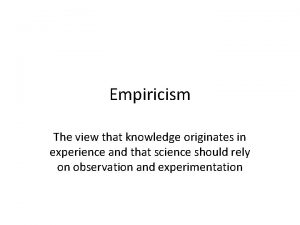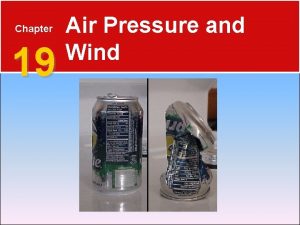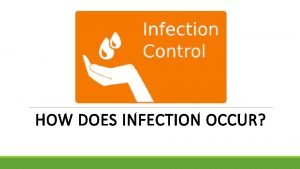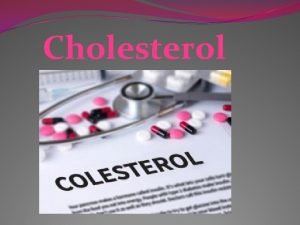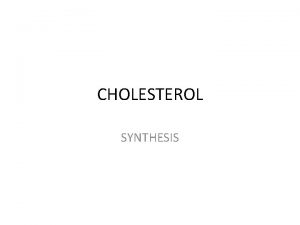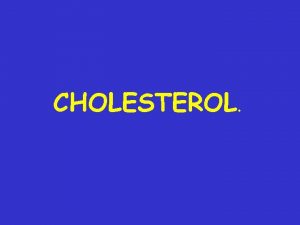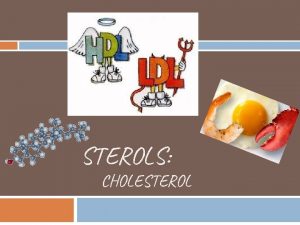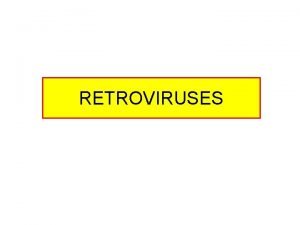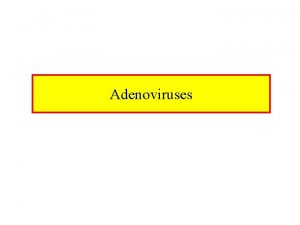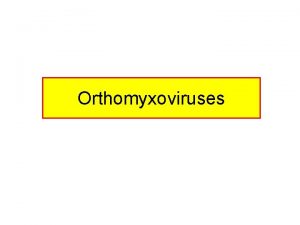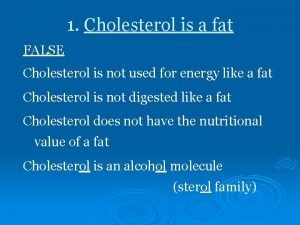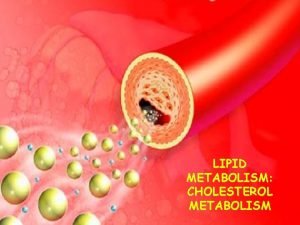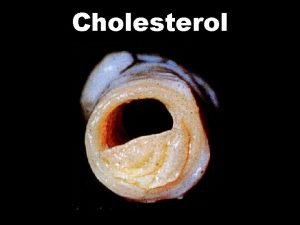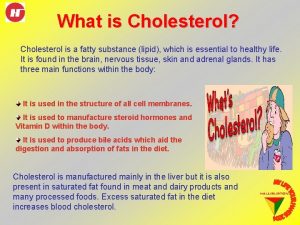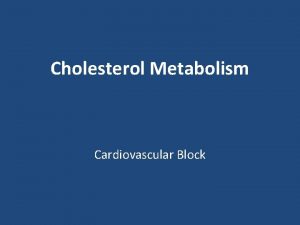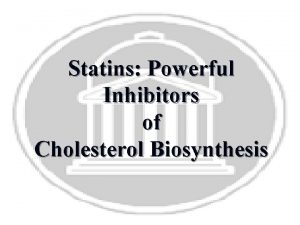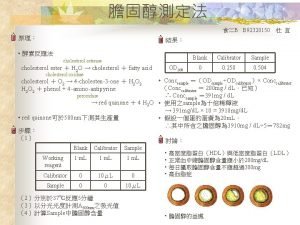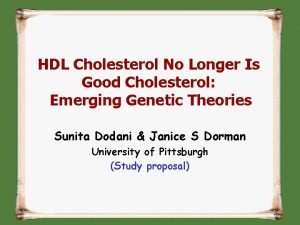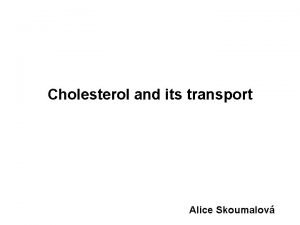Cholesterol Cholesterol p The name cholesterol originates from





















- Slides: 21

Cholesterol

Cholesterol p The name cholesterol originates from the Greek chole(bile )and stereos (solid), and the chemical suffix- ol for an alcohol p Cholesterol is a waxy steroid metabolite found in the cell membranes and transported in the blood plasma of all animals. p It is an essential structural component of mammalian cell membranes, where it is required to establish proper membrane permeability and fluidity.

Cholesterol p In addition, cholesterol is an important component for the manufacture of bile acids , steroid hormones , and fatsoluble vitamins including Vitamin A , Vitamin D , Vitamin E , and Vitamin K. p Cholesterol is the principal sterol synthesized by animals, but small quantities are synthesized in other eukaryotes , such as plants and fungi. It is almost completely absent among prokaryotes , which include bacteria. p Although cholesterol is an important and necessary molecule for animals, a high level of serum cholesterol is an indicator for diseases such as heart disease.

Function of cholesterol p Cholesterol is required to build and maintain membranes ; it regulates membrane fluidity over the range of physiological temperatures. p In many neurons, a myelin sheath, rich in cholesterol, since it is derived from compacted layers of Schwann cell membrane, provides insulation for more efficient conduction of impulses. p Within cells, cholesterol is the precursor molecule in several biochemical pathways.

Function of cholesterol p In the liver, cholesterol is converted to bile , which is then stored in the gallbladder. p Bile contains bile salts, which solubilize fats in the digestive tract and aid in the intestinal absorption of fat molecules as well as the fat-soluble vitamins , Vitamin A , Vitamin D , Vitamin E , and Vitamin K. p Cholesterol is an important precursor molecule for the synthesis of Vitamin D and the steroid hormones , including the adrenal gland hormones cortisol and aldosterone as well as the sex hormones progesterone , estrogens , and testosterone , and their derivatives.

Dietary sources p Animal fats are complex mixtures of triglycerides , with lesser amounts of phospholipids and cholesterol. As a consequence, all foods containing animal fat contain cholesterol to varying extents. Major dietary sources of cholesterol include cheese , egg yolks , beef , pork , poultry , and shrimp. p Human breast milk also contains significant quantities of cholesterol. p The amount of cholesterol is present in plant-based food sources is generally much lower than animal based sources. p In addition, plant products such as flax seeds and peanuts contain cholesterol-like compounds called phytosterols , which are suggested to help lower serum cholesterol levels.

Dietary sources p Total fat intake, especially saturated fat and trans fat, plays a larger role in blood cholesterol than intake of cholesterol itself. p Saturated fat is present in full fat dairy products, animal fats, several types of oil and chocolate. p Trans fats are typically derived from the partial hydrogenation of unsaturated fats

Dietary sources p Trans fat is most often encountered in margarine and hydrogenated vegetable fat, and consequently in many fast foods, snack foods, and fried or baked goods contrast to other types of fat, do not occur in significant amounts in nature. p A change in diet in addition to other lifestyle modifications may help reduce blood cholesterol. Avoiding animal products may decrease the cholesterol levels in the body not only by reducing the quantity of cholesterol consumed but also by reducing the levels of animal-based food consumed and the quantity of cholesterol synthesized.

Synthesis p About 20– 25% of total daily cholesterol production occurs in the liver ; other sites of high synthesis rates include the intestines , adrenal glands , and reproductive organs p Biosynthesis of cholesterol is directly regulated by the cholesterol levels present, though the homeostatic mechanisms involved are only partly understood. p A higher intake from food leads to a net decrease in endogenous production, whereas lower intake from food has the opposite effect. p Cholesterol synthesis can be turned off when cholesterol levels are high, as well.

Plasma transport and regulation of absorption p Since cholesterol is insoluble in blood, it is transported in the circulatory system within lipoproteins p lipoproteins complex spherical particles which have an exterior composed of amphiphilic ( Amphiphile) proteins and lipids whose outwardfacing surfaces are water-soluble and inward-facing surfaces are lipid-soluble p Triglycerides and cholesterol esters are carried internally.

p For this reason, there are several types of lipoproteins within blood called, in order of increasing density , chylomicrons n n very-low-density lipoprotein VLDL intermediate-density lipoprotein IDL low-density lipoprotein LDL high-density lipoprotein HDL. p The more cholesterol and less protein a lipoprotein has the less dense it is. p However, the different lipoproteins contain apolipoproteins , which serve as ligands for specific receptors on cell membranes. In this way, the lipoprotein particles are molecular addresses that determine the start- and endpoints for cholesterol transport.

Chylomicrons, the least dense type of cholesterol transport molecules p Chylomicrons are the transporters that carry fats from the intestine to muscle and other tissues that need fatty acids for energy or fat production. p Cholesterol which is not used by muscles remains in more cholesterol-rich chylomicron remnants, which are taken up from the bloodstream by the liver. p

VLDL and IDL p p p VLDL molecules are produced by the liver and contain excess triacylglycerol and cholesterol that is not required by the liver for synthesis of bile acids. During transport in the bloodstream, the blood vessels cleave and absorb more triacylglycerol to leave IDL molecules, which contain an even higher percentage of cholesterol. The IDL molecules have two possible fates: Half are taken up by the liver for metabolism into other biomolecules and the other half continue to lose triacylglycerols in the bloodstream until they form LDL molecules, which have the highest percentage of cholesterol within them.

LDL p LDL molecules, therefore, are the major carriers of cholesterol in the blood p LDL inters cells via a specific receptors and then, the cholesterol can be used for membrane biosynthesis or esterified and stored within the cell, so as to not interfere with cell membranes.

p many LDL molecules appear in the blood without receptors on the peripheral tissues. These LDL molecules are oxidized and taken up by macrophages, which become engorged and form foam cells. These cells often become trapped in the walls of blood vessels and contribute to artherosclerotic plaque formation. p These plaques are the main causes of heart attacks, strokes, and other serious medical problems, leading to the association of so-called LDL cholesterol (actually a lipoprotein) with "bad" cholesterol.

HDL p p p HDL particles are thought to transport cholesterol back to the liver for excretion or to other tissues that use cholesterol to synthesize hormones in a process known as reverse cholesterol transport) RCT Having large numbers of large HDL particles correlates with better health outcomes In contrast, having small numbers of large HDL particles is independently associated with athermanous disease progression within the arteries.

Metabolism, recycling and excretion p p Cholesterol is oxidized by the liver into a variety of bile acids These in turn are conjugated with glycine , taurine , glucuronic acid , or sulfate. A mixture of conjugated and non-conjugated bile acids along with cholesterol itself is excreted from the liver into the bile. Approximately 95% of the bile acids are reabsorbed from the intestines and the remainder lost in the feces.

hypercholesterolemia p Higher concentrations of LDL and lower concentrations of functional HDL—are strongly associated with cardiovascular disease because these promote atheroma development in arteries (atherosclerosis). p This disease process leads to myocardial infarction (heart attack), stroke, and peripheral vascular disease.

hypercholesterolemia p p p Since higher blood LDL, especially higher LDL particle concentrations and smaller LDL particle size, contribute to this process more than the cholesterol content of the LDL particles, LDL particles are often termed "bad cholesterol" because they have been linked to atheroma formation. On the other hand, high concentrations of functional HDL, which can remove cholesterol from cells and atheroma, offer protection and are sometimes referred to as "good cholesterol". These balances are mostly genetically determined but can be changed by body build, medications, food choices, and other factors.

p p Conditions with elevated concentrations of oxidized LDL particles, especially "small dense LDL" (sd. LDL) particles, are associated with atheroma formation in the walls of arteries, a condition known as atherosclerosis, which is the principal cause of coronary heart disease and other forms of cardiovascular disease. In contrast, HDL particles (especially large HDL) have been identified as a mechanism by which cholesterol and inflammatory mediators can be removed from atheroma. Increased concentrations of HDL correlate with lower rates of atheroma progressions and even regression.

Hypocholesterolemia Abnormally low levels of cholesterol are termed hypocholesterolemia. Research into the causes of this state is relatively limited, but some studies suggest a link with depression , cancer , and cerebral hemorrhage. p In general, the low cholesterol levels seem to be a consequence of an underlying illness, rather than a cause. p
 The view that knowledge originates in experience
The view that knowledge originates in experience Chapter 19 air pressure and wind
Chapter 19 air pressure and wind Types of pathogens
Types of pathogens Name three lines
Name three lines Hình ảnh bộ gõ cơ thể búng tay
Hình ảnh bộ gõ cơ thể búng tay Frameset trong html5
Frameset trong html5 Bổ thể
Bổ thể Tỉ lệ cơ thể trẻ em
Tỉ lệ cơ thể trẻ em Chó sói
Chó sói Glasgow thang điểm
Glasgow thang điểm Hát lên người ơi
Hát lên người ơi Các môn thể thao bắt đầu bằng từ đua
Các môn thể thao bắt đầu bằng từ đua Thế nào là hệ số cao nhất
Thế nào là hệ số cao nhất Các châu lục và đại dương trên thế giới
Các châu lục và đại dương trên thế giới Công thức tính thế năng
Công thức tính thế năng Trời xanh đây là của chúng ta thể thơ
Trời xanh đây là của chúng ta thể thơ Mật thư tọa độ 5x5
Mật thư tọa độ 5x5 Làm thế nào để 102-1=99
Làm thế nào để 102-1=99 độ dài liên kết
độ dài liên kết Các châu lục và đại dương trên thế giới
Các châu lục và đại dương trên thế giới Thể thơ truyền thống
Thể thơ truyền thống Quá trình desamine hóa có thể tạo ra
Quá trình desamine hóa có thể tạo ra
